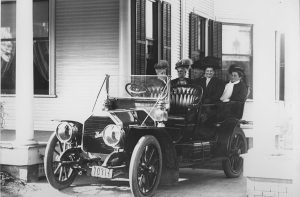As part of the centennial celebration of the University of Illinois, the Mothers Association planned a tribute to the twelve First Ladies of its one hundred year history (1867-1967) during Mother’s Day Week. After much research and planning on the part of the Mothers Association, Illini Notes, the Courier, and the News-Gazette ran articles in April, 1967 “in appreciation for their contributions in furthering and enhancing the worthwhile purposes and goals of the University of Illinois.”[1] Lincoln Square then hosted an exhibit from May 5-13 that included a photographic biography and gowns representing the 25 year periods in the centennial.

University Presidents were well-documented by the University; their wives were not. Little, if any, information on President’s wives resided in permanent University records. Mary Loise Filbey, Assistant to the Dean of Women and Executive Secretary of the Mothers Association, spent hours finding biographical information and photographs for Louisa Catherine Allen Gregory, Mary Panghorn Peabody, Sarah Helen Alexander Burrill, Abbie Louise Lyons Draper, Anna Margaretta Lange James, Kate Ruth Neal Kinley, Lucetta Crum Chase, Eunice Dean Daniels, Sara Lamborn Willard, Margaret Trautwein Stoddard, Edna Cox Morey, and Sarah Henry.
Filbey contacted a number of people to gather information on these women, including family members, friends, and colleagues. Amassing information on President’s wives during the earliest years of the University posed a particular challenge. “When I wrote Professor Burrill’s living relatives in California they could tell me little about his wife, Sadie. Although she lived in this community for 44 years, I couldn’t learn much about her other than that she was a lovely, gentle woman, known as a wonderful mother to her two adopted children and three adopted grandchildren. I suspect that she might have been overshadowed by her husband’s genius.”[2] Some of the later Presidents’ wives corresponded personally; Margaret Stoddard’s verbose reply to the Mothers Association inquiry included a detailed description of a search for “decent pictures that don’t have too dated hats and skirt lengths which are always so ridiculous–particularly in view of the present condition of ladies’ fashion.”[3]

Occasionally, Filbey received less than flattering profiles from correspondents, including this commentary from Stewart S. Howe regarding Lucetta Chase: “I cannot think of anyone who cared enough or knew Mrs. Chase well enough to refer you to such a person. As you probably know, she was plenty unpopular with the faculty wives and lady faculty members while a resident at Urbana…at least I can recall only hearing criticism about her believed-to-be icy personality and seeming snubbery.” [4] This comment was tactfully omitted from the Mothers Association tribute and subsequent newspaper specials. However, Filbey’s May presentation Reading Between the Lines for the County Chairman Banquet and a meeting of the wives of Theoretical and Applied Mechanics was more forthcoming. In addition to a brief overview of each woman’s contribution to the University, Filbey included amusing stories and frank commentary. Evidently not only did Lucetta Chase smoke, a taboo habit in those days, she regularly took to her bed and had “someone else to act as hostess for the weekly Monday afternoon open house. She may or may not have been physically ill. I suspect that she couldn’t face those Monday affairs–with the curiosity and gossip of the faculty wives.”[5]

Mary Alice Panghorn, wife of second President Selim Peabody, was a particular favorite of Filbey’s, who was “impressed by her courageous spirit of adventure and her longing for color and beauty that resulted in her bringing the dandelions to the mid-west frontier. She seems to have the dandelions’ quality to endure and her personality reflected the optimism of the first dandelion that blooms despite chilly spring weather.” [6] Peabody and Filbey may have appreciated the plant’s colorful, robust attributes in the late nineteenth century, but now dandelions are frequently viewed as a weedy pest.
After a brief account of each woman in Reading Between the Lines, Filbey concluded that “The leadership and achievements of the University Presidents and their wives have all been affected by political, social and economic events, the size and rate of growth of the University, and the attitudes and values of the people during the period of their administrations. It is unfair to compare the Presidents or the First Ladies. Each has sacrificed his or her personal life and privacy in their service to the University of Illinois. Each has given his or her best.”
[1] A Tribute to the First Ladies of the University of Illinois, News-Gazette, April 30, 1967.
[2] Mary Loise Filbey, Reading Between the Lines, Presidents’ Wives File, Record Series 41/3/15, Student Life & Culture Archives.
[3] Margaret Stoddard to Mary Filbey, March 7, 1967, Presidents’ Wives File, Record Series 41/3/15, Student Life & Culture Archives.
[4] Stewart S. Howe to Mary Filbey, April 19, 1967, Presidents’ Wives File, Record Series 41/3/15, Student Life & Culture Archives.
[5] Mary Loise Filbey, Reading Between the Lines, Presidents’ Wives File, Record Series 41/3/15, Student Life & Culture Archives.